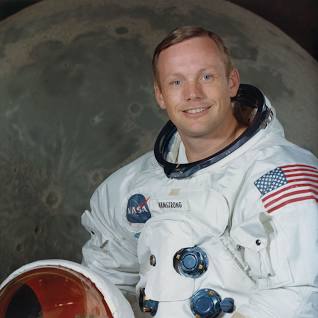Many people remember Neil Armstrong’s saying, “That’s one small step for man, One giant leap for mankind.” He was an American astronaut, soldier, and aerospace engineer. He led the historic Apollo 11 mission to become the first human to walk on the Moon, accompanied by Buzz Aldrin and Michael Collins. Neil Armstrong was born on August 5, 1930, in Wapakoneta, Ohio, and passed away on August 25, 2012, in Cincinnati, Ohio.
He had an early ambition to become an aerospace aviator. After graduating from high school, Neil Armstrong earned a bachelor’s degree from Purdue University in 1955 and a master’s degree from the University of Southern California in 1970. Prior to his death, he contributed to several projects.
Armstrong’s space project in both piloting and engineering aspects of numerous projects, including the X-15 hypersonic rocket plane, affected the beginning of a new space odyssey. Let’s examine some of his noteworthy achievements and his life.
Neil Armstrong, an American hero, served as a Navy fighter pilot during the Korean War and completed 78 sorties. Additionally, he worked as a test pilot for multiple aircraft, such as the X-15, capable of reaching speeds up to 6,437 kilometers per hour.
In our collective memory, Neil Armstrong is revered for his achievement of being the first person to set foot on the Moon. Serving as the commander of Apollo 11, the mission took only four days to reach the lunar surface. However, the preparation for this historic event required almost ten years of work by around 400,000 individuals at a cost of $24 billion. On the day of Apollo 11’s launch, a million people lined the highways and beaches near the space station, and an estimated 700 million people watched on television.
The Saturn V rocket carrying Apollo 11 lifted off from the Kennedy Space Center at 13:32 UTC (9:32 local time) on July 16, 1969. Twelve minutes later, the vehicle entered Earth orbit. After circling the Earth one and a half times, the S-IVB third stage engine pushed the spacecraft into a lunar orbit with a TLI burn (Trans Lunar Injection burn). Thirty minutes later, the Apollo Command/Service Module separated from the last remaining Saturn V rocket fuselage and merged with the lunar module within the Lunar Module Adapter.
After flying for four days, Apollo 11 entered lunar orbit. Armstrong and Aldrin boarded the lunar lander, Eagle, which landed on the Moon. On July 20, 1969, at 4:17:40 p.m., the first humans in history set foot on the Moon! The duo spent about six hours inside Eagle, readying to exit. At 10:56 p.m., Armstrong made his way out of the Eagle and took the historic first step. After extensive training in lunar-like environments, the lunar surface, with its lower gravity than Earth, proved to be a difficult walk for Armstrong and Aldrin. They proceeded to collect soil and rock samples from the surface and installed scientific instruments previously arranged. Their time on the Moon lasted two and a half hours before departing on the 21st.
Neil Armstrong and Edwin Aldrin became the first humans to set foot on the Moon, while crewmember Michael Collins remains in orbit aboard the Apollo 11 spacecraft. As an estimated 723 million people worldwide witness the historic moment through televised broadcast, the United States emerges triumphant in the race for space. Armstrong’s contributions to spaceflight technology revolutionized engineering, as he pioneered new approaches to spacecraft design and testing, ultimately enabling us to uncover the mysteries of the universe.
Armstrong revolutionized history as the commander of the Apollo 11 mission, successfully landing humans on a celestial body for the first time and accomplishing President John F. Kennedy’s objective of landing humans on the Moon and bringing them back to Earth by the end of the decade.
The Moon will serve as a vital testing ground for technologies and resources necessary to advance human space exploration to Mars and beyond, encompassing the creation of an enduring, reusable infrastructure. Though the Apollo missions concluded in 1972, NASA and the global community maintain an ongoing fascination with this celestial body.
Through the Artemis program, NASA intends to send the first female astronaut to the Moon, utilizing cutting-edge technologies to survey a more comprehensive range of its surface than ever before. We will work together with commercial and international partners to set up the initial permanent settlement on the Moon.
Armstrong, the pioneering astronaut who became the first human to set foot on the Moon, was born on August 5, 1930, in Wapakoneta, Ohio. He commenced his NASA career in Ohio, following his tenure as a naval aviator from 1949 to 1952. In 1955, Armstrong joined the National Advisory Committee for Aeronautics (NACA) and began a phase of his mission that would shape space exploration for generations to come. We can learn the importance of humility, composure, and concentration from Neil Armstrong, the first human to walk on the Moon.
By: Hyeju Ha
Write and Win: Participate in Creative writing Contest & International Essay Contest and win fabulous prizes.
















